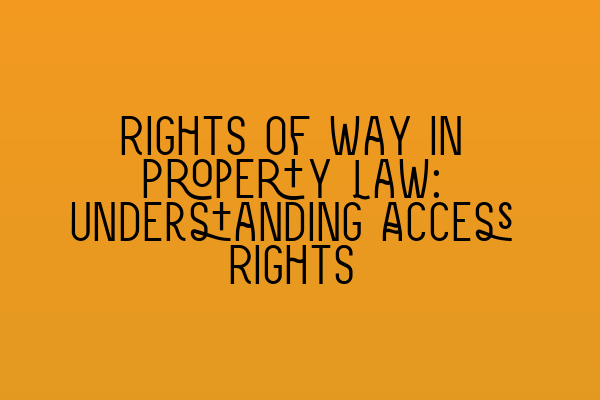Rights of Way in Property Law: Understanding Access Rights
When it comes to property law, there are many important aspects to consider, and one of them is the concept of rights of way. Understanding access rights is crucial for property owners, as it can have a significant impact on their use and enjoyment of their land. In this blog post, we will delve into the topic of rights of way in property law and provide a comprehensive overview of this important legal concept.
What is a Right of Way?
A right of way is a legal right that allows a person to pass through another person’s land to reach a particular destination. It provides an individual with the legal right to use a specific path or passage, even if they do not own the land over which the right of way exists. The purpose of a right of way is to ensure that properties that are physically separated are still accessible.
Types of Rights of Way
There are two main types of rights of way: private and public. Let’s explore each of them in more detail:
1. Private Rights of Way: Private rights of way are established by mutual agreement between the landowners involved. They are usually set out in written documents, such as deeds or agreements, and specify the exact terms and conditions of use. Private rights of way can be granted for various purposes, such as accessing a neighboring property, reaching a public road, or gaining entry to a specific area.
2. Public Rights of Way: Public rights of way, on the other hand, are rights that are available to the general public and cannot be easily restricted or revoked by landowners. They are typically established based on historical usage or by specific legislation. Public rights of way include footpaths, bridleways, and byways, and are often marked by signage or shown on official maps. It’s important to note that landowners cannot obstruct or interfere with public rights of way.
How are Rights of Way Established?
The establishment of rights of way can vary depending on the circumstances. Here are some common ways in which rights of way are created:
1. Express Grant: A right of way may be granted explicitly by a landowner to another party through a written document, such as a deed or contract. The terms and conditions of the right of way should be clearly stated in the document, including the purpose, route, and any limitations or restrictions.
2. Implication: In some cases, a right of way may be implied by the actions or conduct of the parties involved. This can occur when the use of a particular route or path is essential for the reasonable enjoyment of the dominant land. However, the specific circumstances must support the inference that a right of way was intended.
3. Prescription: A right of way can also be established through prescription, which is based on long and uninterrupted use of a particular route. To claim a prescriptive right of way, the use must have been continuous, without interruption, and without the landowner’s permission for a specified period of time. The length of time required for prescription can vary depending on the jurisdiction.
Resolving Disputes over Rights of Way
Unfortunately, disputes over rights of way can arise, often due to disagreements between landowners or changes in land use. If you find yourself in a dispute over a right of way, there are several steps you can take to try to resolve the issue:
1. Communication: Start by engaging in open and respectful communication with the other party involved. Clearly express your concerns and try to understand their point of view. Oftentimes, disputes can be resolved amicably through negotiation and compromise.
2. Mediation: If direct communication does not lead to a resolution, it may be beneficial to involve a neutral third party, such as a mediator. A mediator can help facilitate discussions and guide both parties towards a mutually acceptable solution.
3. Legal Action: In some cases, legal action may be necessary to settle a dispute over a right of way. Consulting with an experienced property law solicitor can provide you with the guidance and support needed to navigate the legal process effectively.
Conclusion
Understanding rights of way is essential for property owners, as it can significantly impact their use and enjoyment of their land. Whether you are considering granting a right of way or are involved in a dispute over access rights, seeking professional legal advice is crucial to ensure your rights are protected. At SQE Property Law & Land Law, our team of expert solicitors can provide you with the guidance and assistance you need. Contact us today to schedule a consultation.
Related Articles:
– SQE 1 Practice Exam Questions
– SQE 1 Practice Mocks FLK1 FLK2
– SQE 2 Preparation Courses
– SQE 1 Preparation Courses
– SRA SQE Exam Dates
